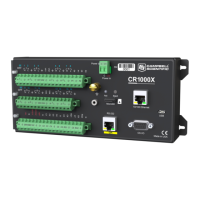l Sensor address ( a): A single character and the first character of the command. Sensors are
usually assigned a default address of zero by the manufacturer. The wildcard address ( ?) is
used in the Address Query command. Some manufacturers may allow it to be used in
other commands. SDI-12 sensors accept addresses 0 through 9, a through z, and A through
Z.
l Command body (for example, M1): An upper case letter (the “command”) followed by
alphanumeric qualifiers.
l Command termination ( !): An exclamation mark.
An active sensor responds to each command. Responses have several standard forms and
terminate with <CR><LF> (carriage return–line feed).
7.7.2 SDI-12 programmed mode/recorder mode
The datalogger can be programmed to read SDI-12 sensors or act as an SDI-12 sensor itself. The
SDI12Recorder() instruction automates sending commands and recording responses. With
this instruction, the commands to poll sensors and retrieve data is done automatically with
proper elapsed time between the two. The datalogger automatically issues retries. See CRBasic
Editor help for more information on this instruction.
Commands entered into the SDIRecorder() instruction differ slightly in function from similar
commands entered in transparent mode. In transparent mode, for example, the operator
manually enters aM! and aD0! to initiate a measurement and get data, with the operator
providing the proper time delay between the request for measurement and the request for data.
In programmed mode, the datalogger provides command and timing services within a single line
of code. For example, when the SDI12Recorder() instruction is programmed with the M!
command (note that the SDI-12 address is a separate instruction parameter), the datalogger
issues the aM! and aD0! commands with proper elapsed time between the two. The datalogger
automatically issues retries and performs other services that make the SDI-12 measurement work
as trouble free as possible.
For troubleshooting purposes, responses to SDI-12 commands can be captured in programmed
mode by placing a variable declared As String in the variable parameter. Variables not
declared As String will capture only numeric data.
7.7.3 Programming the datalogger to act as an SDI-12
sensor
The SDI12SensorSetup() / SDI12SensorResponse() instruction pair programs the
datalogger to behave as an SDI-12 sensor. A common use of this feature is to copy data from the
datalogger to other Campbell Scientific dataloggers over a single data-wire interface (terminal
7. Communications Protocols 96

